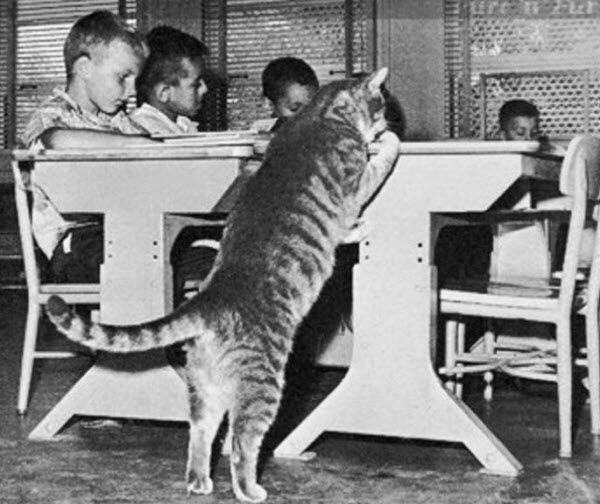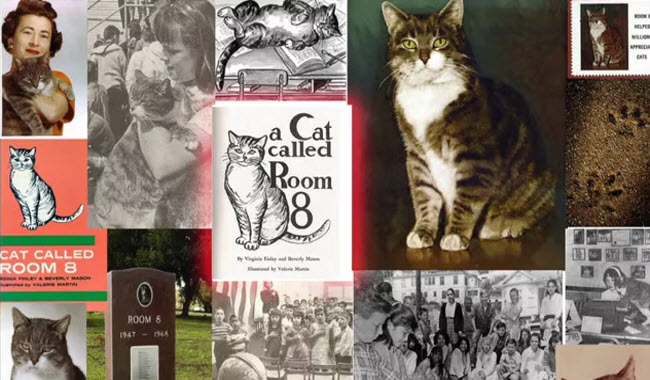If you ever travel to California, USA, and find yourself exploring Echo Park Avenue in Los Angeles, you might come across a symbolic mural along the edge of Elysian Heights Elementary School. This mural is inscribed with words of love and remembrance, but if you look closely, you’ll notice that these words aren’t dedicated to a person. Instead, they pay tribute to a domestic shorthair cat named Room 8, who lived at the school during the 1960s and was beloved by both students and teachers. Interestingly, the cat only appeared during the school year and would disappear when the year ended, with no one knowing where it went. When school resumed, Room 8 would return as if it were one of the students, and over time, the cat played a big role in shaping the school and contributing to the education of its pupils.
Room 8’s story began one school day in 1952 when a large, but thin, gray-striped shorthair cat wandered into the school and entered a sixth-grade classroom. The cat walked across the students’ desks in a friendly manner, and the children were delighted by its presence. The teacher was initially unsure about allowing the cat to stay, but when the children pointed out how thin it was, she agreed to give it some milk. Later that day, when the children returned from recess, they found the cat napping on a desk after having opened some of their lunchboxes, scattering food around the room. The cat later followed them to the lunch hall, where they shared more food. After another nap, the cat left through the school gate, and the children didn’t expect to see it again.

However, to their surprise, the next morning, the cat followed the students back to class. To alleviate the teacher’s concerns, the children adopted the cat and, lacking a name, one student suggested calling it “Room 8” after their classroom number. As the daily routine continued, the cat eventually became the school’s unofficial mascot, often found patrolling the hallways or napping on desks. It frequently joined the children for lunch, even though they weren’t supposed to feed it. Over time, the cat gained weight, and a sixth-grade student was assigned the coveted role of “cat feeder.” This position became the most prestigious one in the school, as feeding Room 8 took place in the teachers’ lounge, an area typically off-limits to students. The school also implemented a strict rule: “Do not disturb the cat.” If Room 8 interfered too much with class activities, it would be gently relocated elsewhere.

Despite the strong bond between the students, teachers, and Room 8, no one knew where the cat went at night or during school holidays. Some speculated it might sleep in the nearby hills. The school principal, a friend of Room 8, later revealed in a book that the cat had been born in 1947, making it five years old when it first came to the school. He explained that the cat had likely been mistreated in its previous home and found a second, happier home at the school. Room 8 became a natural part of school life, especially remarkable for returning each September at the start of the new school year.
As Room 8’s fame grew, local media began to cover its story, with the cat appearing in local cat shows and becoming an honorary member of several organizations. In late 1962, Look magazine published a three-page feature about Room 8, and a biography was published in 1966, which went through six editions. An article about the cat appeared in a national elementary school publication the following year, and Room 8 even featured in a television documentary shortly before its death. At the height of its fame, Room 8 received as many as 100 letters a day from fans across the U.S. and abroad, totaling about 10,000 letters. Some letters included cash donations, which were used to buy books for the school library, further contributing to the school’s development. Fifth and sixth graders acted as Room 8’s secretarial team, answering the letters and signing them with a rubber stamp. This process helped the students improve their writing skills and understand the value of work.

As Room 8 grew older, health problems began to surface. The cat made annual visits to the vet, lost several teeth, and in 1963 suffered a serious injury during a cat fight. The most serious ailment came when Room 8 developed pneumonia, but with treatment from Lockhart Animal Hospital in Hollywood, it made a full recovery. As the cat aged, it accepted more care from neighbors and friends near the school, particularly the Nakano family, who provided it with a safe place to stay at night when school was out. They would even carry Room 8 across the street to ensure it crossed safely. Sometimes, the cat would disappear at night, prompting searches until it was found, often sleeping in someone’s garden or visiting a neighbor. Room 8 enjoyed the increasing attention it received as it aged. Sadly, it passed away from kidney failure on August 13, 1968, at the age of 21, a common cause of death for older cats.

After Room 8’s death, the news was widely reported in newspapers and magazines. The Los Angeles Times ran its obituary with a photo spanning three columns, a rare honor. The news was also covered by The Christian Science Monitor. Room 8 was buried at the Los Angeles Pet Memorial Park in Calabasas, with only a few people in attendance since the school was on summer break. The Nakano family placed a wreath of roses and carnations on the grave, noting that these had been the cat’s favorite flowers to smell in their garden. Later, a memorial was erected at the site, which can still be seen today.

In the aftermath of Room 8’s passing, a charity fund was established in its name to benefit a local hospital, with students making the first donations. Although the cat was gone, the fund raised $10,000, a significant sum at the time. Another charity in Room 8’s name was founded in 1972 to shelter stray cats and animals. In 1969, a petition was started to honor Room 8 with a U.S. Postal Service stamp, although this goal was never realized. Nonetheless, the cat did appear on a special commemorative stamp in the 1970s. More than fifty years later, Elysian Heights Elementary School still remembers Room 8, with memorabilia such as a plaque in the school library and two paintings in the hallway next to a larger version of its commemorative medal. Each year, first and second graders receive a book about Room 8, which their teachers read to them, ensuring that the school never forgets its unique cat.
